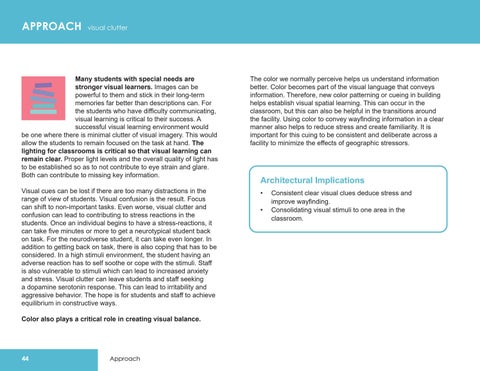APPROACH
visual clutter
Many students with special needs are stronger visual learners. Images can be powerful to them and stick in their long-term memories far better than descriptions can. For the students who have difficulty communicating, visual learning is critical to their success. A successful visual learning environment would be one where there is minimal clutter of visual imagery. This would allow the students to remain focused on the task at hand. The lighting for classrooms is critical so that visual learning can remain clear. Proper light levels and the overall quality of light has to be established so as to not contribute to eye strain and glare. Both can contribute to missing key information. Visual cues can be lost if there are too many distractions in the range of view of students. Visual confusion is the result. Focus can shift to non-important tasks. Even worse, visual clutter and confusion can lead to contributing to stress reactions in the students. Once an individual begins to have a stress-reactions, it can take five minutes or more to get a neurotypical student back on task. For the neurodiverse student, it can take even longer. In addition to getting back on task, there is also coping that has to be considered. In a high stimuli environment, the student having an adverse reaction has to self soothe or cope with the stimuli. Staff is also vulnerable to stimuli which can lead to increased anxiety and stress. Visual clutter can leave students and staff seeking a dopamine serotonin response. This can lead to irritability and aggressive behavior. The hope is for students and staff to achieve equilibrium in constructive ways. Color also plays a critical role in creating visual balance.
44
Approach
The color we normally perceive helps us understand information better. Color becomes part of the visual language that conveys information. Therefore, new color patterning or cueing in building helps establish visual spatial learning. This can occur in the classroom, but this can also be helpful in the transitions around the facility. Using color to convey wayfinding information in a clear manner also helps to reduce stress and create familiarity. It is important for this cuing to be consistent and deliberate across a facility to minimize the effects of geographic stressors.
Architectural Implications • •
Consistent clear visual clues deduce stress and improve wayfinding. Consolidating visual stimuli to one area in the classroom.






















